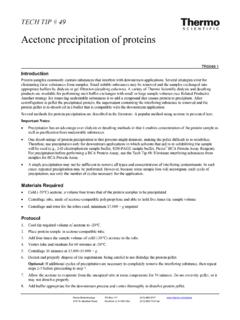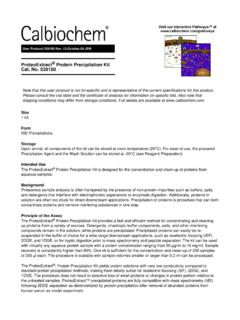Transcription of Solubilization of Trichloroacetic Acid (TCA) Precipitated ...
1 Solubilization of Trichloroacetic acid (TCA) Precipitated MicrobialProteins via NaOH for Two-Dimensional ElectrophoresisM. P. Nandakumar, Jie Shen, Babu Raman, and Mark R. Marten*Department of Chemical & Biochemical Engineering, University of Maryland, Baltimore County (UMBC),1000 Hilltop Circle, Baltimore, Maryland 21250 Received June 23, 2002 Abstract:In preparing intracellular microbial samples forone- or two-dimensional electrophoresis, trichloroaceticacid (TCA) precipitation is frequently used to removeinterfering compounds. Solubilization of TCA precipitatetypically requires the addition of a number of chaotropesor detergents, in a multistep process, that requires hoursto carry out.
2 In this study, a simple, rapid, one-stepmethod to solubilize TCA Precipitated proteins is pre-sented. Precipitated proteins are pretreated with MNaOH for less than 5 min, followed by addition ofstandard sample Solubilization buffer (SSSB). When com-pared to Solubilization with SSSB alone, NaOH pretreat-ment of TCA- Precipitated intracellular protein fromAs-pergillus oryzaeandEscherichia colishows an approximate5-fold increase in soluble protein . In addition, two-dimensional gel electrophoresis on resolubilized proteinsshows an equivalent number of proteins in samples withand without NaOH :proteins proteomics Aspergillus oryzae Escheri-chia coliIntroductionThe preparation of intracellular microbial proteins for two-dimensional gel electrophoresis (2-DE) typically includes lysisof the cell membrane or wall, inactivation or removal ofinterfering substances, and Solubilization of sample this process, it is of great importance to minimizeprotein modification or degradation, thus avoiding a quantita-tive loss of high molecular weight proteins, membrane proteins,and/or nuclear such, three important goals insample preparation are as follows.
3 (i) complete dissociationof protein / protein interactions, (ii) removal of nonproteinsample components ( , lipids, nucleic acids, and salts), and(iii) significant reduction or elimination of protease the second and third items can be addressed indi-vidually by dialysis and addition of protease inhibitors, to acertain extent, all three goals can be met in a single step: precipitation of sample proteins followed by resuspension insample Solubilization of proteins using Trichloroacetic acid (TCA;alone, or in combination with acetone ) is a popular samplepreparation method for both 1-D and 2-D electrophoresis,4,5because it can concentrate samples, remove salts, and polysac-charides,6and denature endogenous ,8 However,resolubilization of Precipitated protein is often difficult,4,5,8andthis is especially true for proteins Precipitated with example, current protocols for resolubilization of TCAprecipitate are quite time-consuming4(Table 1), and can takeup to 24 h.
4 Alternatively, this time can be reduced to ap-proximately 3 to4hbyaddition of a number of solubilizingagents ( , chaotropes, surfactants, reducing agents, etc.).5,8-11 These, however, can lead to protein modifications or aggrega-tion, which have the potential to interfere with bettermethod for resolubilization of TCA Precipitated protein resolubilizing protein precipitate for 1-D gels12or totalprotein determination,13pretreatment with alkali solution hasbeen used to enhance solubility. In this study, we report on amodified alkali pretreatment method for resolubilization of TCAprecipitated proteins for 2-DE (Table 1).
5 Using intracellularprotein from the filamentous fungusA. oryzaeand the bacte-riumE. coli, we show simple pretreatment of TCA precipitatewith mild alkali is rapid, requires addition of no potentiallyinterfering components, leads to significant Solubilization of* To whom correspondence should be addressed. Phone: (410) : (410) 455-1049. E-mail: Required for the Steps Involved in Various 2-DEProtein Preparation ProtocolsaStandard protocol4involves addition of standard sample solubilizationbuffer (SSSB), followed by vortexing for solubilization8requires addition of a number of solubilizing agents, some of which havebeen reported to interfere with described in Materials andMethods, pretreatment of precipitate with approximately 20 L M NaOHfor 2 min.
6 Volume then brought to 500 L with proteinmay be solubilized if precipitate is frozen overnight, thawed, and vortexedagain requiring a total of approximately 24 CCC: $ 2003 American Chemical SocietyJournal of Proteome Research2003, 2, 89-9389 Published on Web 11/06/2002 Downloaded by UNIV NOVA DE LISBOA on October 8, 2009 | Publication Date (Web): November 6, 2002 | doi: precipitate, and does not reduce the number of visibleproteins or the quality of 2-D and MethodsA. oryzaeGrowth and Cell Lysis typeAspergillus oryzae(A1560; derived from strain IFO 4177,institute for fermentation, Osaka, Japan) was obtained fromNovozymes North America, Inc.
7 (Franklinton, NC). Storage,media, and growth conditions for this strain have beendescribed lyse fungal cells, a mechanical celldisruption method was , the harvestedmycelial biomass (500 mg wet weight) and an equal amountof acid washed glass beads ( mm) were added toa2mLEppendorf tube containing 1 mL lysis buffer (20 mM Tris-HCl pH , 10 mM NaCl, mM deoxycholate, and 40 L/mlof protease inhibitor cocktail (Sigma Chemical Co, St. Louis,MO). The mixture was agitated in a Mini-BeadBeater (BioSpec,USA) at top speed, for 8 min (repeated cycles of 30 s onfollowed by 30 s cooling on ice).)
8 The supernatant obtained aftercentrifugation was then treated with DNase/RNase (SigmaChemical Co, St. Louis, MO). Finally, the supernatant dividedinto two fractions (proteins from each fraction later used fordifferent types of resolubilization procedure) was furthertreated with 20% v/v TCA ( Trichloroacetic acid , Sigma ChemicalCo, St. Louis, MO) in ice for 30 min to precipitate protein . Theprecipitate was collected by centrifugation at 6000 g for 10 minat 4 C. The Precipitated protein was washed with acetone toremove traces of TCA and finally acetone was removed byspeed vacuum coliGrowth and Cell Lysis coliwild typestrain W3110 was obtained from the Coli Genetic Stock Center(CGSC; New Haven, CT).
9 Storage, media, and growth conditionsfor this strain have been described ,17 Intracellularprotein sample for electrophoresis was prepared according tothe protocol from with the following variations in the lysis buffer ( DTT instead of mM DTE and mM PMSF instead mM Pefabloc SC). After suspension in the lysis buffer, thecells were lysed by sonication (550 Sonic Dismembrator, FisherScientific, USA) at 40% power in ice. Cell debris was removedby centrifugation, DNAse/RNAse were added to the super-natant, and incubated for 30 min in ice. This protein samplewas divided into two fractions (proteins from each fractionslater used for different types of resolubilization procedure) andsubjected to 20% v/v TCA precipitation followed by acetonewashing and drying in speed vacuum similar to theA.
10 Oryzaeprotein Precipitated protein pelletsof microbial intracellular proteins were solubilized by twomethods. In the first, TCA precipitate was resolubilized in 500 l of standard sample Solubilization buffer (SSSB; 8M Urea, 4%w/v CHAPS, 1% w/v DTT; Sigma Chemical Co, St. Louis, MO)and Ampholytes 2% v/v 3-10 nonlinear (NL; AmershamBiosciences, San Francisco, CA, USA) alone. After 2-3hofintermittent vortexing, the sample was frozen at-80 C forapproximately 15 h (overnight). The sample was then thawedand subjected to an additional 2-3 h of vortexing (totalresolubilization time approximately 24 h).









